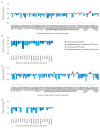PGC-1α, a potential therapeutic target for early intervention in Parkinson's disease
- PMID: 20926834
- PMCID: PMC3129986
- DOI: 10.1126/scitranslmed.3001059
PGC-1α, a potential therapeutic target for early intervention in Parkinson's disease
Abstract
Parkinson's disease affects 5 million people worldwide, but the molecular mechanisms underlying its pathogenesis are still unclear. Here, we report a genome-wide meta-analysis of gene sets (groups of genes that encode the same biological pathway or process) in 410 samples from patients with symptomatic Parkinson's and subclinical disease and healthy controls. We analyzed 6.8 million raw data points from nine genome-wide expression studies, and 185 laser-captured human dopaminergic neuron and substantia nigra transcriptomes, followed by two-stage replication on three platforms. We found 10 gene sets with previously unknown associations with Parkinson's disease. These gene sets pinpoint defects in mitochondrial electron transport, glucose utilization, and glucose sensing and reveal that they occur early in disease pathogenesis. Genes controlling cellular bioenergetics that are expressed in response to peroxisome proliferator-activated receptor γ coactivator-1α (PGC-1α) are underexpressed in Parkinson's disease patients. Activation of PGC-1α results in increased expression of nuclear-encoded subunits of the mitochondrial respiratory chain and blocks the dopaminergic neuron loss induced by mutant α-synuclein or the pesticide rotenone in cellular disease models. Our systems biology analysis of Parkinson's disease identifies PGC-1α as a potential therapeutic target for early intervention.
Conflict of interest statement
Figures






References
-
- Dhillon AS, Tarbutton GL, Levin JL, Plotkin GM, Lowry LK, Nalbone JT, Shepherd S. Pesticide/environmental exposures and Parkinson’s disease in East Texas. J Agromedicine. 2008;13:37. - PubMed
-
- Chade AR, Kasten M, Tanner CM. Nongenetic causes of Parkinson’s disease. J Neural Transm. 2006;(Suppl):147. - PubMed
-
- Park HJ, Kim HJ, Park HK, Chung JH. Protective effect of histamine H2 receptor antagonist ranitidine against rotenone-induced apoptosis. Neurotoxicology. 2009 Nov;30:1114. - PubMed
-
- Betarbet R, Sherer TB, MacKenzie G, Garcia-Osuna M, Panov AV, Greenamyre JT. Chronic systemic pesticide exposure reproduces features of Parkinson’s disease. Nat Neurosci. 2000 Dec;3:1301. - PubMed
Publication types
MeSH terms
Substances
Associated data
- Actions
- Actions
- Actions
- Actions
- Actions
- Actions
- Actions
- Actions
- Actions
- Actions
- Actions
- Actions
- Actions
- Actions
- Actions
Grants and funding
- P01 NS058793/NS/NINDS NIH HHS/United States
- R01 NS064155/NS/NINDS NIH HHS/United States
- P30AG19610/AG/NIA NIH HHS/United States
- R24MH068855/MH/NIMH NIH HHS/United States
- R01NS049221/NS/NINDS NIH HHS/United States
- K08 AG024816/AG/NIA NIH HHS/United States
- R21NS060227/NS/NINDS NIH HHS/United States
- R01NS064155/NS/NINDS NIH HHS/United States
- P01NS058793/NS/NINDS NIH HHS/United States
- R21 NS060227/NS/NINDS NIH HHS/United States
- K08AG024816/AG/NIA NIH HHS/United States
- P30 AG019610/AG/NIA NIH HHS/United States
- R24 MH068855/MH/NIMH NIH HHS/United States
- R01 NS049221/NS/NINDS NIH HHS/United States
LinkOut - more resources
Full Text Sources
Other Literature Sources
Medical
Molecular Biology Databases

